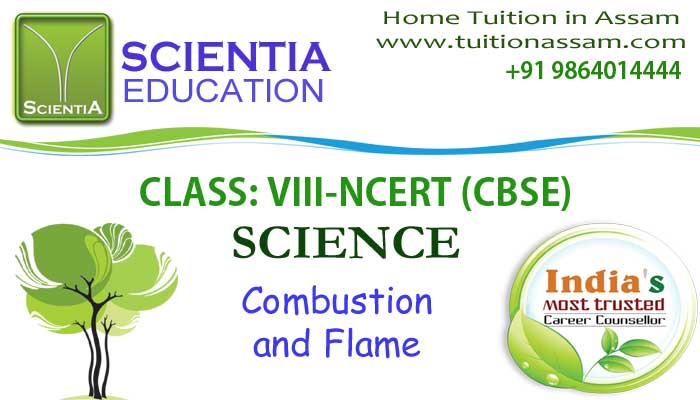
CLASS: VIII NCERT (CBSE)
Chemistry
Combustion And Flame
SUMMARY
Combustion
The chemical process in which a substance reacts withoxygen to give off heat is called combustion.
A substance that undergoes combustion is called acombustible substance, or a fuel.
Liquefied Petroleum Gas or LPG burns very quickly producing a lot of heat. This is called rapid combustion.
When white phosphorous is left out in the open at room temperature for some time, it burns all by itself. This is called spontaneous combustion.
Forest fires and fires in coal mines are because ofspontaneous combustion.
The burning of crackers produces a large amount of heat, light and sound because of chemical reaction. This type of combustion is called explosion.
Without oxygen, even a combustible substance will not burn.
Temperature is an important condition for combustionto occur.
The lowest temperature at which a substance catches fire is called its ignition temperature.
Kerosene is a fuel that has a low ignition temperature.
A low ignition temperature means the substance willcatch fire quickly and is highly inflammable. Someinflammable substances are petrol, LPG, ether andalcohol.
A matchstick is made of a mixture of antimony trisulphide and potassium chlorate mixed with a little bit of red phosphorous.
A lighter depends on lighter fluid, which is highly inflammable as well. It is made out of naphtha or liquid butane.
Air, heat and fuel are needed for a fire to be created.
Fire can be easily stopped by stopping the supply of either air or heat.
Water is not a good extinguisher for electrical fires. Ifelectrical wiring is on fire, pouring water on it willconduct the electricity through the water and may cause the person dousing the fire to be electrocuted.
As water is heavier than petrol, it is not useful forextinguishing oil or petrol fires. For electrical and oil fires, it is best to use carbon dioxide as an extinguisher. Carbon dioxide is heavier than oxygen, so it covers the flame like a blanket, cutting off contact between the fuel and oxygen. Powder of sodium or potassium bicarbonate can also be used to get carbon dioxide.
The first automatic fire extinguisher was patented inEngland by a celebrated chemist called French C. Hopffer.
The modern fire extinguisher was invented by British Captain George William Manby.
Flame
Kerosene oil and molten wax are substances that give a flame while burning.
Wood and charcoal are substances that do notvaporise, but still burn, without any flame.
A luminous flame is a bright yellow flame that gives off light. A luminous flame undergoes incomplete combustion as it does not get the oxygen that itrequires.
A non-luminous flame is colourless and is much hotter. A non-luminous flame undergoes complete combustionas it draws much more oxygen and gets much hotter.
There are several “zones” within a non-luminous flame, and each zone has a different temperature
The outermost zone of the flame is blue in colour and it is the hottest part. This is due to complete combustion.
The middle zone is moderately hot and is yellow in colour. This is because of partial combustion.
The innermost zone is the least hot and black in colour.This is due to the presence of unburned wax vapours.
Fuel
Fuel is any material that is burned to obtain energy that can be used to heat or move another object. Fuel releases energy through a chemical reaction known ascombustion.
A good fuel must:
• Be readily available.
• Be cheap.
• Burn easily at a moderate rate.
• Produce a large amount of heat.
• Not leave behind any undesirable substances.
Wood was the first fuel that was used 2 million years ago by homo erectus, the predecessor of human beings.
Calorific value is defined as the amount of heat energyproduced on complete combustion of 1 kilogram of a fuel. It is expressed in a unit called kilojoule per kg. Thehigher the calorific value of a fuel, the more is its efficiency.
Each kilogram of LPG produces much more heat thanone kilogram of wood or coal. The calorific value of LPG is the highest among wood, charcoal and LPG.
In rural areas, cow dung and wood are still used as fuelbecause these are very cheap and easily available.
However, burning wood produces a lot of smoke, which is very harmful to humans, since it causes respiratory problems.
Cutting down trees for fuel also leads to deforestation, which harms the environment and also deprives us of all the other benefits of trees.
Unburned carbon particles released when carbon fuelslike wood, coal and petroleum burn, cause pollutionand respiratory diseases such as asthma.
Incomplete combustion of carbon fuels causes therelease of carbon monoxide – a very harmful gas.
Combustion of fuels causes the release of carbon dioxide, which leads to global warming. Such rise in temperatures can cause melting of polar glaciers, arise in sea level, and the flooding of low-lying areas of the world.
Oxides of sulphur and nitrogen dissolve in rain water to form acid rain, which ruins soil, crops and buildings.
By choosing the right fuel, we can reduce the negative impact on the environment. A great example of this iscars, buses and auto rickshaws that run onCompressed Natural Gas, or CNG, instead of petrol.CNG is a much cleaner and cheaper fuel.













